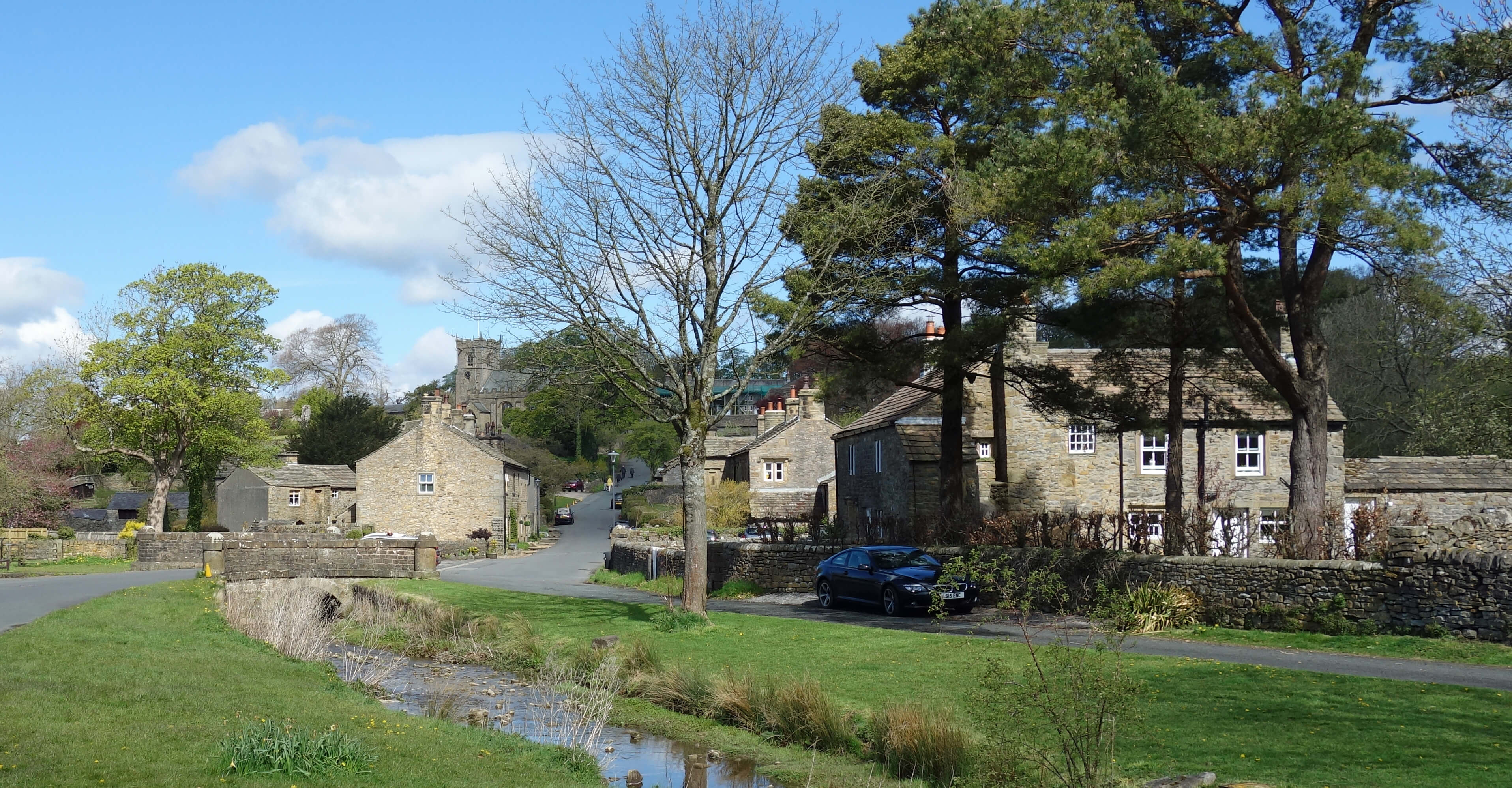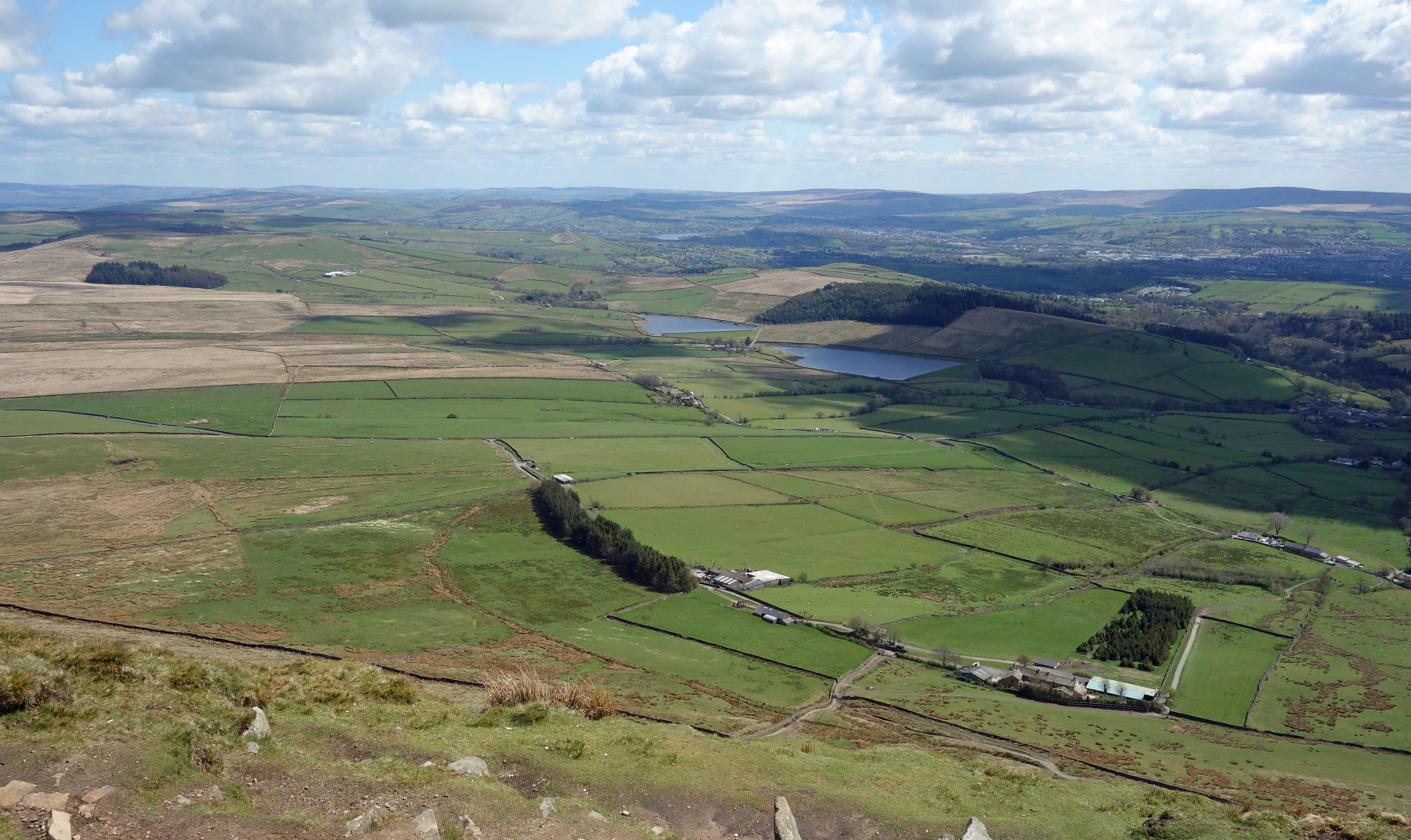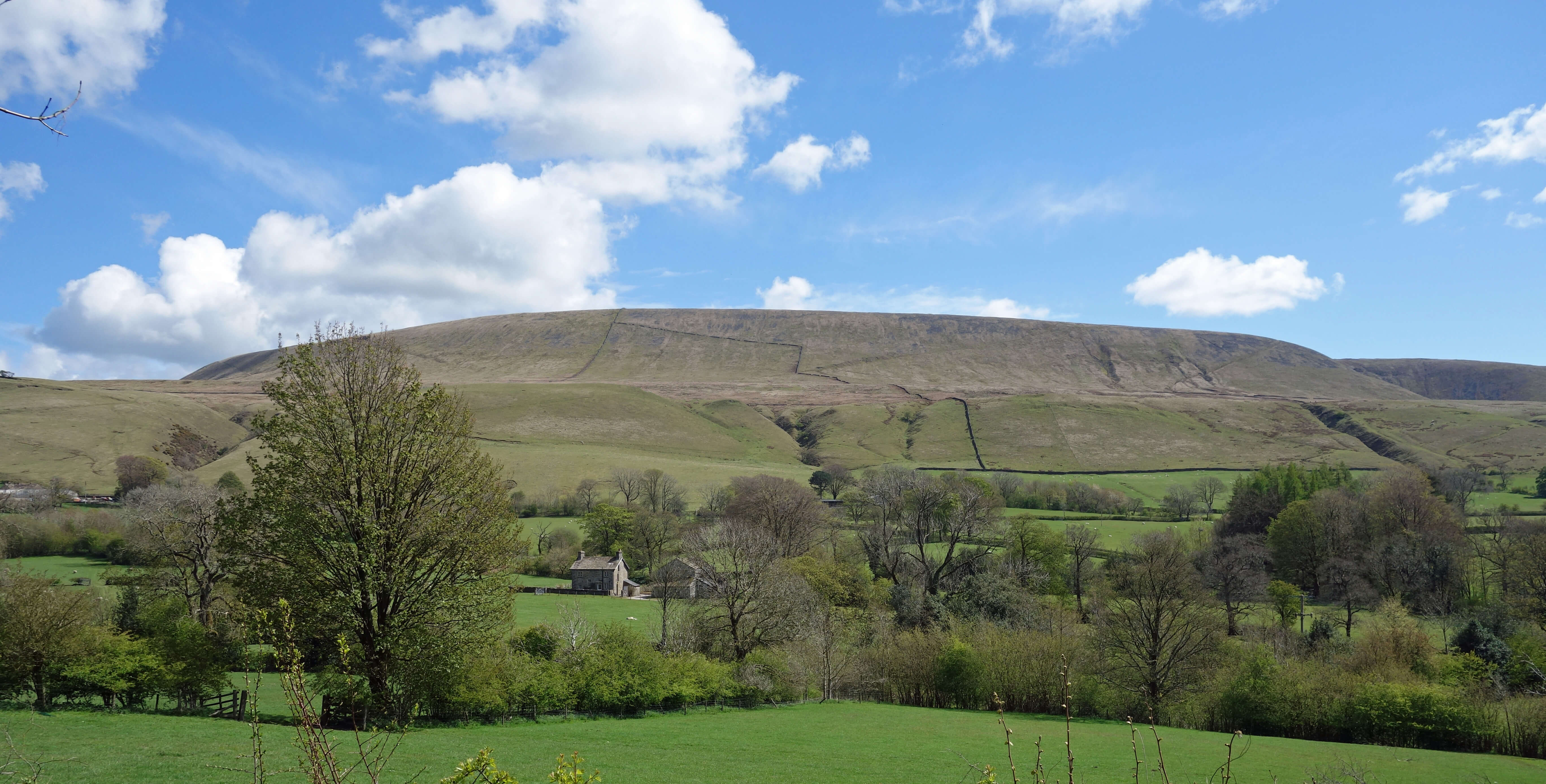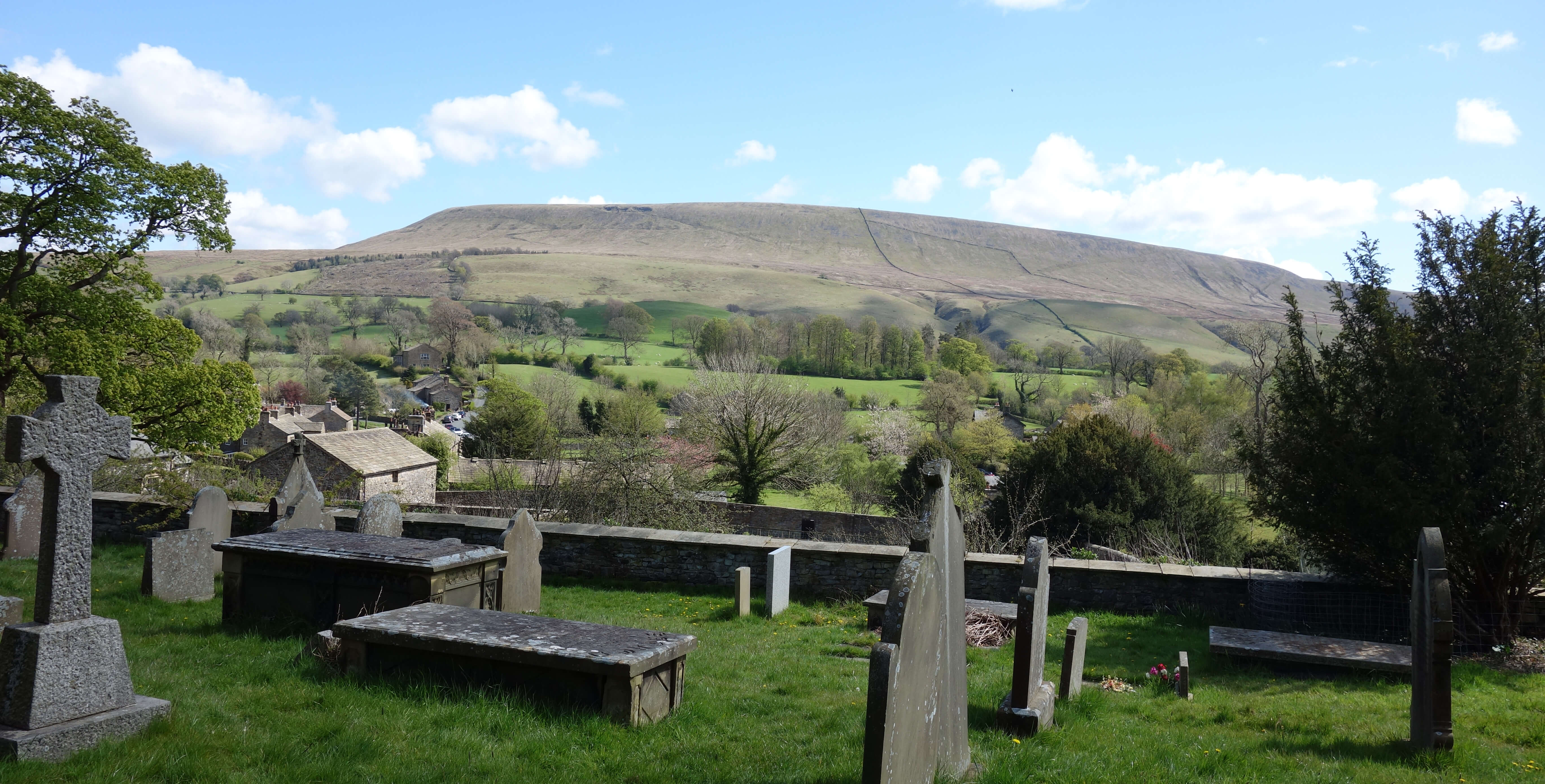
Home
Preamble
Index
Areas
Map
References
Me
Drakkar
Saunterings: Walking in North-West England
Saunterings is a set of reflections based upon walks around the counties of Cumbria, Lancashire and
North Yorkshire in North-West England
(as defined in the Preamble).
Here is a list of all Saunterings so far.
If you'd like to give a comment, correction or update (all are very welcome) or to
be notified by email when a new item is posted - please send an email to johnselfdrakkar@gmail.com.
129. From the Delights of Downham to the Heights of Pendle
 Right: Downham.
Right: Downham.
We set off walking from the village of Downham, which is a few miles north-east of Clitheroe. The
Downham website
states, with false modesty, that “It is often hailed as the most beautiful village in Lancashire”. However, we had
a hill to walk up first. The delights of Downham could wait until we returned, if we had any time and energy left.
We walked east on a pleasant path by Downham Beck, passing Clay House, which is, I read, “a good example
of the revived vernacular style” of the region. Crossing Pendle Road, we then followed a permissive path
across Downham Moor all
the way to the top of Pendle (557 metres). I appreciate the permissive path across the first field but beyond that it is
all open access land. We don’t need permission to use
the path there, so why isn’t it just marked on the map as a path? Anyway, it was a good path, easy to
follow and obviously well-used. It provided excellent views across the Ribble valley to the southern Bowland hills and
to the distant Dales hills, which we were
surprised to see covered in fresh May snow.
The last time I came here
(Sauntering 20) they were repairing the path along the top.
The result is so fittingly unobtrusive that I can excuse the embellishment of the trig point, now surrounded by
circles of stones. We sat on the eastern edge with our sandwiches, with
swallows swooping along the hillside, and with the view shown below.
Pendle now has such a myriad of well-worn paths that we felt the need to escape for some moorland yomping.
So we set off west, where we found that some of the boggy bits now have straw bales to ensure that they become boggier
and thus retain their peat. We found a step-stile in Oaken Clough and continued by the wall to reach another
so-called permissive path. We ignored it and instead walked more on the western edge in order to better enjoy the
view of Bowland and the Dales (where the snow had now all but melted away). We could also see below us the route
back to Downham and dropped steeply down the slopes to pick up the path near Burst Clough.
On the path past Worsaw Hill there were fine views back to Pendle.

The view from the Pendle lunch spot

The view of Pendle, from near Downham
Back in Downham, we strolled around its lanes, up to the pub (re-opening in June) and the
church. A visitor who had read nothing about Downham and who had been deposited in its
Main Street would probably find the surroundings calmly reassuring but oddly unsettling.
It would be like finding oneself in a village from the pages of an Enid Blyton or Topsy
and Tim book. Downham seems more of a museum or a model than a natural village of 2021.
A Lancashire Life article
explains why Downham is as it is. The region has been owned and managed for centuries by the Assheton
family of Downham Hall. Their directions ensure that, as the article says, “Downham hasn’t changed
since the 1950s”. There are no television aerials, satellite dishes, overhead wires, or road markings. There
was no sign to the car-park either, but we had skilfully found it anyway. Surely it is better to help
visitors find where to park than leave them to clutter the lanes, where there are, of course, no yellow lines.
 Left: The Clitheroe arms.
Left: The Clitheroe arms.
The present manager of the estate, the Hon. Ralph Christopher Assheton, 3rd Baron Clitheroe in waiting, is quoted as saying “We agreed to a bus timetable next to the telephone box, but there’s no sign for the bus stop. We don’t need it.” What about those who have commendably taken the
bus from Preston for a day’s visit to Downham? No doubt the Hon. Ralph doesn’t need a bus stop sign – or even a bus.
 Right: Pendle from the Downham church.
Right: Pendle from the Downham church.
The directives of the Assheton family are no concern of mine but I think I’m allowed to comment on the
principle of this arrangement. The Hon. Ralph may be the epitome of an English country gentleman and may have
the Wisdom of Solomon but how can Downham residents, while no doubt grateful that the place is kept so spick and
that someone pays for work, such as the planting of trees, in the local environment,
accept that one man has the right to determine what is allowed in their
village? How can one man assume that he has the God-given (or parent-given)
right to make such decisions on
their behalf? Are there other villages in England where such feudalism still exists?
Yes, there are. The
Who owns England? website
lists a number of them: Albury (Duke of Northumberland); Eridge (Marquess of Abergavenny); Firle (Viscount Gage); Glynde (Viscount
Hampden); Yattendon (Baron Iliffe). At least the Asshetons don’t insist that all
the houses, none of which is privately owned, are in the family colours. Albury, for example, is all green. Unless, perhaps, the Assheton
colour is white. Everything is stone grey or white, apart from the red telephone box. We didn’t inspect
it to determine whether it was a stage prop or functional. If the latter, I expect that it requires the use of shillings, tanners, threepenny bits and old pennies.
The 1950s mirage is maintained not just by the absence of modern appendages to houses but by the
absence of modern houses. As far as I could tell, there are no post-1950 houses in Downham. My own
village has grown from about 20 houses in 1950 to about 200 now. And it has, like most villages, recently
had to develop a ‘neighbourhood plan’ detailing, amongst other things, where more new houses may be built.
Is Downham exempt from such requirements? We noticed that Downham doesn’t opt out of the refuse collection services. Do Downham residents pay Council Tax, although they may
pick and choose what services they make use of? At all events, it seems unfair to acclaim Downham as the most beautiful village in Lancashire when it is playing by its own special rules that make it hardly a village.
The present manager is the son of Ralph John Assheton, 2nd Baron Clitheroe, who is the son of
Ralph Assheton, 1st Baron Clitheroe, who was the son of Sir Ralph Cockayne Assheton, 1st Baronet. There are some
women in the family tree too. All four Ralphs went to Eton College. I see from his Wikipedia page
that the 2nd Baron was Deputy Chief Executive of the Rio Tinto Group, a company well-known to environmentalists, and that in 1955 he became a Liveryman for the Worshipful Company of Skinners. What an achievement!
If having old Etonians assuming a right to
determine whether we may have a bus stop sign and much else besides and having a populace happy to accept
that they do indeed have that right results in such a charming, harmonious, local society then
perhaps we should try it at a national level. Oh.
Date: May 5th 2021
Start: SD785441, Downham car-park (Map: OL21 or OL41)
Route: E by Downham Park, SE past Clay House – Lane Head – S, SE on permissive path – Pendle Big End – SW – Ogden Clough – NW by wall, SW, NW by Burst Clough, NE, NW, NE – Worsaw End – N – Downham
Distance: 6 miles; Ascent: 425 metres
Home
Preamble
Index
Areas
Map
References
Me
Drakkar
© John Self, Drakkar Press, 2018-

Top photo: The western Howgills from Dillicar;
Bottom photo: Blencathra from Great Mell Fell


 Right: Downham.
Right: Downham.


 Left: The Clitheroe arms.
Left: The Clitheroe arms.
 Right: Pendle from the Downham church.
Right: Pendle from the Downham church.
